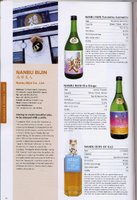
We had a very successful saké tasting/dinner party at our house this past Thursday evening. Our friends Mayu and Wes came over early and Mayu made an extraordinary meal of vegetable aspic, soba noodles, tofu and daikon salad with goma dressing, garlic grilled chicken wings, grilled summer vegetables, and stir-fried eggplant, pork and garlic chives with miso. Our friends Patrick and Sophie brought sticky rice with durian, thai custard, and mango for dessert. I provided the saké.
 Our first saké of the evening was a surprise smash hit. I was worried about what the boys would think as I poured a cloudy, sparkling saké (Harushika Tokimeki “Palpitation of Saké” sparkling junmai saké, SMV –80, acidity 5.5), but to my surprise, everyone said they loved it and would drink it again. As expected, it was very sweet, but it also had a very distinctive "saké" taste. This saké isn't available locally, so I had to order it from True Sake in San Francisco and I will definitely be ordering more!
Our first saké of the evening was a surprise smash hit. I was worried about what the boys would think as I poured a cloudy, sparkling saké (Harushika Tokimeki “Palpitation of Saké” sparkling junmai saké, SMV –80, acidity 5.5), but to my surprise, everyone said they loved it and would drink it again. As expected, it was very sweet, but it also had a very distinctive "saké" taste. This saké isn't available locally, so I had to order it from True Sake in San Francisco and I will definitely be ordering more!Next, we had a comparison tasting of three junmai sakés:
~Fukucho “Moon on the Water” junmai ginjo (Seimaibuai 55%, SMV +3, acidity 1.4)
~Ginga shizuka “Divine Droplets” junmai daiginjo (Seimaibuai 50%, SMV +3, acidity 1.2)
~Kanbara “Bride of the Fox” junmai ginjo (Seimaibuai 50%, SMV +3, acidity 1.6)
Mayu liked the very dry "Divine Droplets," while everyone else preferred the Kanbara "Bride of the Fox."

I served the next tasting in white paper cups. I did a bit of testing beforehand and determined that the cups were neutral in taste and scent so I went ahead with them, disregarding their total lack of elegance.
This tasting was actually guessing game with four sakés including a nama, a taru (cedar aged) saké, a very dry junmai, and a honjozo.
~Ichinokura taru saké (Seimaibuai 55%)
~Kagatobi yamahai Junmai (Seimaibuai 65%, SMV +12, acidity 1.8)
~Kaguyahime “Princess of Bamboo” honjozo junmai (SMV –2 acidity 1.1)
~Ohyama “Big Mountain” nama (SMV +3, acidity 1.5)
The only sad part of the night is that the photographer (me) did a horrible job and most of the pictures turned out dark or blurry. Well, now we have a good reason to have another tasting and I've already got some more "games" in mind!






